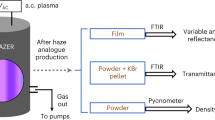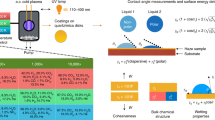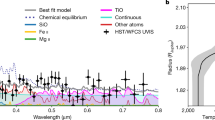Abstract
Numerous Solar System atmospheres possess photochemically generated hazes, including the characteristic organic hazes of Titan and Pluto. Haze particles substantially impact atmospheric temperature structures and may provide organic material to the surface of a world, potentially affecting its habitability. Observations of exoplanet atmospheres suggest the presence of aerosols, especially in cooler (<800 K), smaller (<0.3× Jupiter’s mass) exoplanets. It remains unclear whether the aerosols muting the spectroscopic features of exoplanet atmospheres are condensate clouds or photochemical hazes1,2,3, which is difficult to predict from theory alone4. Here, we present laboratory haze simulation experiments that probe a broad range of atmospheric parameters relevant to super-Earth- and mini-Neptune-type planets5, the most frequently occurring type of planet in our galaxy6. It is expected that photochemical haze will play a much greater role in the atmospheres of planets with average temperatures below 1,000 K (ref. 7), especially those planets that may have enhanced atmospheric metallicity and/or enhanced C/O ratios, such as super-Earths and Neptune-mass planets8,9,10,11,12. We explored temperatures from 300 to 600 K and a range of atmospheric metallicities (100×, 1,000× and 10,000× solar). All simulated atmospheres produced particles, and the cooler (300 and 400 K) 1,000× solar metallicity (‘H2O-dominated’ and CH4-rich) experiments exhibited haze production rates higher than our standard Titan simulation (~10 mg h–1 versus 7.4 mg h–1 for Titan13). However, the particle production rates varied greatly, with measured rates as low as 0.04 mg h–1 (for the case with 100× solar metallicity at 600 K). Here, we show that we should expect great diversity in haze production rates, as some—but not all—super-Earth and mini-Neptune atmospheres will possess photochemically generated haze.
This is a preview of subscription content, access via your institution
Access options
Access Nature and 54 other Nature Portfolio journals
Get Nature+, our best-value online-access subscription
$29.99 / 30 days
cancel any time
Subscribe to this journal
Receive 12 digital issues and online access to articles
$119.00 per year
only $9.92 per issue
Buy this article
- Purchase on Springer Link
- Instant access to full article PDF
Prices may be subject to local taxes which are calculated during checkout



Similar content being viewed by others
Change history
16 March 2018
In the version of this Letter originally published Table 2, which tabulates the production rates shown in Fig. 3, was mistakenly omitted. It has now been included in all versions of the Letter.
References
Knutson, H. A., Benneke, B., Deming, D. & Homeier, D. A featureless transmission spectrum for the Neptune-mass exoplanet GJ436b. Nature 505, 66–68 (2014).
Kreidberg, L. et al. Clouds in the atmosphere of the super-Earth exoplanet GJ1214b. Nature 505, 69–72 (2014).
Sing, D. K. et al. A continuum from clear to cloudy hot-Jupiter exoplanets without primordial water depletion. Nature 529, 59–62 (2016).
Morley, C. V. et al. Thermal emission and reflected light spectra of super Earths with flat transmission spectra. Astrophys. J. 815, 110 (2015).
Hu, R. & Seager, S. Photochemistry in terrestrial exoplanet atmospheres. III. Photochemistry and thermochemistry in thick atmospheres on super Earths and mini Neptunes. Astrophys. J. 784, 63 (2014).
Fressin, F. et al. The false positive rate of Kepler and the occurrence of planets. Astrophys. J. 766, 81 (2013).
Moses, J. I. et al. Disequilibrium carbon, oxygen, and nitrogen chemistry in the atmospheres of HD 189733b and HD 209458b. Astrophys. J. 737, 15 (2011).
Line, M. R., Vasisht, G., Chen, P., Angerhausen, D. & Yung, Y. L. Thermochemical and photochemical kinetics in cooler hydrogen-dominated extrasolar planets: a methane-poor GJ436b? Astrophys. J. 738, 32 (2011).
Miller-Ricci Kempton, E., Zahnle, K. & Fortney, J. J. The atmospheric chemistry of GJ 1214b: photochemistry and clouds. Astrophys. J. 745, 3 (2012).
Moses, J. I. et al. Compositional diversity in the atmospheres of hot Neptunes, with application to GJ 436b. Astrophys. J. 777, 34 (2013).
Venot, O., Agúndez, M., Selsis, F., Tessenyi, M. & Iro, N. The atmospheric chemistry of the warm Neptune GJ 3470b: influence of metallicity and temperature on the CH4 /CO ratio. Astron. Astrophys. 562, A51 (2014).
Morley, C. V. et al. Forward and inverse modeling of the emission and transmission spectrum of GJ 436b: investigating metal enrichment, tidal heating, and clouds. Astronom. J. 153, 86 (2017).
He, C. et al. Carbon monoxide affecting planetary atmospheric chemistry. Astrophys. J. Lett. 841, L31 (2017).
Cable, M. L. et al. Titan tholins: simulating titan organic chemistry in the Cassini–Huygens era. Chem. Rev. 112, 1882–1909 (2012).
Elkins-Tanton, L. T. & Seager, S. Ranges of atmospheric mass and composition of super-Earth exoplanets. Astrophys. J. 685, 1237–1246 (2008).
Schaefer, L., Lodders, K. & Fegley, B. Vaporization of the Earth: application to exoplanet atmospheres. Astrophys. J. Lett. 755, 41 (2012).
Fortney, J. J. et al. A framework for characterizing the atmospheres of low-mass low-density transiting planets. Astrophys. J. 775, 80 (2013).
Sullivan, P. W. et al. The Transiting Exoplanet Survey Satellite: simulations of planet detections and astrophysical false positives. Astrophys. J. 809, 77 (2015).
Gao, P., Marley, M. S., Zahnle, K., Robinson, T. D. & Lewis, N. K. Sulfur hazes in giant exoplanet atmospheres: impacts on reflected light spectra. Astronom. J. 153, 139 (2017).
Moses, J. I., Madhusudhan, N., Visscher, C. & Freedman, R. S. Chemical consequences of the C/O ratio on hot Jupiters: examples from WASP-12b, CoRoT-2b, XO-1b, and HD 189733b. Astrophys. J. 763, 25 (2013).
Raulin, F., Mourey, D. & Toupance, G. Organic syntheses from CH4–N2 atmospheres: implications for Titan. Orig. Life 12, 267–279 (1982).
DeWitt, H. L. et al. Reduction in haze formation rate on prebiotic Earth in the presence of hydrogen. Astrobiology 9, 447–453 (2009).
Sciamma-O’Brien, E., Carrasco, N., Szopa, C., Buch, A. & Cernogora, G. Titan’s atmosphere: an optimal gas mixture for aerosol production? Icarus 209, 704–714 (2010).
Imanaka, H. & Smith, M. A. Formation of nitrogenated organic aerosols in the Titan upper atmosphere. Proc. Natl Acad. Sci. USA 28, 12423–12428 (2010).
Trainer, M. G., Jimenez, J. L., Yung, Y. L., Toon, O. B. & Tolbert, M. A. Nitrogen incorporation in CH4–N2 photochemical aerosol produced by far ultraviolet irradiation. Astrobiology 12, 315–326 (2012).
Trainer, M. G. et al. Haze aerosols in the atmosphere of early Earth: manna from heaven. Astrobiology 4, 409–419 (2004).
Miller, S. L. A production of amino acids under possible primitive Earth conditions. Science 117, 528–529 (1953).
Hörst, S. M. & Tolbert, M. A. The effect of carbon monoxide on planetary haze formation. Astrophys. J. 781, 53 (2014).
Bar-Nun, A. & Chang, S. Photochemical reactions of water and carbon monoxide in Earth’s primitive atmosphere. J. Geophys. Res. Oceans 88, 6662–6672 (1983).
Marley, M. S., Gelino, C., Stephens, D., Lunine, J. I. & Freedman, R. Reflected spectra and albedos of extrasolar giant planets. I. Clear and cloudy atmospheres. Astrophys. J. 513, 879–893 (1999).
Acknowledgements
This work was supported by National Aeronautics and Space Administration Exoplanets Research Program grant NNX16AB45G. C.H. was supported by the Morton K. and Jane Blaustein Foundation.
Author information
Authors and Affiliations
Contributions
S.M.H., N.K.L., C.H., M.S.M. and J.I.M. conceived the study. J.I.M. calculated the starting gas mixtures. C.H. performed the experiments and measurements. S.M.H. prepared the manuscript. All authors participated in discussions regarding interpretation of the results and edited the manuscript.
Corresponding author
Ethics declarations
Competing interests
The authors declare no competing interests.
Additional information
Publisher’s note: Springer Nature remains neutral with regard to jurisdictional claims in published maps and institutional affiliations.
Rights and permissions
About this article
Cite this article
Hörst, S.M., He, C., Lewis, N.K. et al. Haze production rates in super-Earth and mini-Neptune atmosphere experiments. Nat Astron 2, 303–306 (2018). https://doi.org/10.1038/s41550-018-0397-0
Received:
Accepted:
Published:
Issue Date:
DOI: https://doi.org/10.1038/s41550-018-0397-0
This article is cited by
-
Diamond precipitation dynamics from hydrocarbons at icy planet interior conditions
Nature Astronomy (2024)
-
Optical properties of organic haze analogues in water-rich exoplanet atmospheres observable with JWST
Nature Astronomy (2023)
-
Organic hazes will impact JWST observations of water-rich exoplanets
Nature Astronomy (2023)
-
A reflective, metal-rich atmosphere for GJ 1214b from its JWST phase curve
Nature (2023)
-
UV absorption by silicate cloud precursors in ultra-hot Jupiter WASP-178b
Nature (2022)



